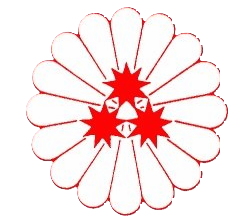Rev. Jikai (慈海) Dehn:

Reverend Jikai 慈海 Tyler Dehn grew up Catholic, but became a Buddhist at the age of 15 during a year-long exchange in Toyama (富山県), Japan. Jikai had been interested in Buddhism for as long as he can remember, and during his exchange, he was fortunate enough to live in a ‘temple-district’ or teramachi 寺町. Surrounded by multiple temples of various denominations, Jikai began his Buddhist journey in earnest. During the week he would read whichever Buddhist sūtras he could get his hands on, and then on weekends he would ride his bicycle to various temples, attending services and asking many questions.
While reading the Lotus Sūtra, Jikai had what he calls a “lightning-bolt moment”. Though his understanding of Buddhism was still very rudimentary, something about this sūtra struck him with an intensity he still struggles to explain rationally. As a result of this experience, he began investigating the Nichiren sects intensively. While he enjoyed spending time with a community sharing his new-found passion for the Lotus Sūtra, it wasn’t until he stumbled upon the works of Tiantai Dashi Zhiyi (the Chinese founder of Tendai), that he experienced his next intense and deeply moving “religious experience”. While reading through Tiantai Dashi Zhiyi’s Fahua Wenju 法華文句 (JP: Hokke Mongu; ENG: Words and Phrases of the Dharma Flower Sūtra), Jikai distinctly remembers audibly exclaiming “Kore da! 此れだ!i.e. This is it!” His life has been shaped by these two experiences ever since, and taken turns no one could have predicted.
During the remainder of his exchange in Japan, he visited Tendai temples in the neighbouring Ishikawa Prefecture 石川県, and had the good fortune to travel with his host-family to the Head Temple 総本山 of the Tendai School 天台宗, Enryakuji 延暦寺 on Mount Hiei 比叡山. For Jikai, the atmosphere at Enryakuji had the same sweet fragrance that the Lotus Sūtra, and the words of Tiantai Dashi Zhiyi had had. Jikai knew that he would return to Mt Hiei, but perhaps didn’t realise to what end he would later do so.


After returning to Australia he contacted Reverend Jiryo 慈了Moxon who was running a small Tendai community in Brisbane, Australia. Though Jiryo Sensei and Jikai lived in very different parts of Australia, they managed to meet a few times a year and regularly made contact. Via Jiryo Sensei, Jikai was introduced to the late Archbishop Ara Ryokan 荒了寛大僧正 of the Hawaii Tendai Mission ハワイ天台別院 in Honolulu. Shortly thereafter Jikai became a lay disciple of Ara Ryokan and assisted with various observances and events such as the annual Cowra Breakout Memorial Services.
During one of Ara Sensei’s visits to Australia, Ara Sensei was showcasing his artwork at the Japan Foundation in Sydney. Jiryo Sensei and Jikai spent the trip assisting and soaking up the knowledge that Ara Sensei so readily gave. One afternoon Ara Sensei pulled Jikai aside and spent quality-time chatting with Jikai about what had brought him to Tendai in depth. The discussion remains a treasured memory of Jikai’s, and was followed up with a discussion later that evening which has directed his efforts ever since. Jikai had mentioned his two “lightning-bolt” moments to Ara Sensei, and after having mulled over them for a few hours, Ara Sensei once again pulled Jikai aside.


Ara Sensei impressed upon Jikai how important such experiences were in a karmic sense. Ara Sensei advised Jikai that such goen 御縁 or “karmic connections” were no mere accident, and should not be ignored. Given these goen, Ara Sensei reminded Jikai that “those who hear these teachings are rare indeed; of those who hear them, those who have the faith to lodge them firmly in one’s heart are rarer still; of those who have faith in them, those who have the dedication to study them are rarer again; and of those who are dedicated enough to study them, those who are willing to practise them are rarer still”. “Given that you have come upon these rare circumstances” Ara Sensei said, “Don’t you think you have a duty to be more than just a lay follower here in Australia?”.
Jikai asked Ara Sensei if he thought Jikai was “good enough” to ordain? To which his reply was that: “one should always think of oneself as the lowest of the low 下座, and if you can do that until the end, you’ll be a good Monk.” Shortly thereafter Jikai took Home-leaving Ordination or Shukke Tokudo 出家得度 at the Tendai Hawaii Mission or Tendai Hawaii Betsuin 天台ハワイ別院 in Honolulu, Hawaii. Jikai’s Ordination was then recorded at the official Administrative Office of the Tendai Sect 天台宗務庁, in Japan, and he thereupon became an officially registered Tendai monk. After this, Jikai began training as a monk and disciple of Bishop Ara. Every year he travelled to Honolulu Hawaii for a few months of training, and assisted with temple activities.


Finally, in 2015 Jikai was accepted to, and attended the Seminary Programme on Mt Hiei 比叡山延暦寺 known as Gyoin 行院. At Gyoin Jikai learnt the fundamental rites and rituals of a Tendai clergyman, and performed the Sanzen Butsu Raihai 三千佛礼拝 or Three Thousand Prostrations to the Buddhas of the past, present and future. He embraced the Samaya Precepts 三昧耶戒, practised the Four Esoteric Rites or Shidokegyō 四度加行, and successfully completed the Gyo programme 満行. The severity and strictness of Gyoin are legendary, and its reputation as a site of spiritual cultivation, unsurpassed. Among the many schools of Japanese Buddhism, Gyoin is largely recognised as one of the most thorough and rigorous of all training centres in Japan. This incredibly powerful spiritual regimen is an immensely personal experience of one’s own limitations, expectations, and a “fire-like” cultivation of one’s inner potential. This means that everyone who completes Gyoin comes out of it with differing experiences, and that no explanation of the events can fully prepare one for their own personal Gyo 行 (ascetic cultivation).
After the completion of his training, Jikai moved to Tokyo 東京, and worked at the Tendai High School of Komagome Gakuen 駒込学園 for five years. During this time, he assisted a number of temples, participated in seminars on behalf of Tendai Shu and translated various materials into English. In his role at Komagome Gakuen, Jikai assisted with both English-language trips to Hawaii and Australia, as well as Retreat-excursions at famous Tendai temples such as Enryakuji, and Nikkouzan Rinnouji 日光山 輪王寺.



At the end of 2020 he returned to Australia, and now operates the Tendai Buddhist Sangha of Australia at Enmitsuji Temple (圓密寺) in the Hawkesbury Region, NSW. They offer weekly lessons on Tiantai/Tendai Teachings and instruction in meditation, chanting and making offerings. Enmitsuji Temple also celebrates various events on the Buddhist Annual Calendar, and offers Services and Memorials for all who request them.
Reverend Jikai Dehn holds a Master of Research Degree from Macquarie University, and has made it his life-long labour of love, to translate Buddhist sūtras and Tendai texts, in hopes that the seeds of the Buddha-Dharma may be firmly planted in the soils of the West. He hopes that his humble temple library, consisting of crates of texts which he brought back from Japan, will be the start of meaningful engagement with the Dharma-texts in his homeland.
Though ordained and trained in the Tiantai/Tendai tradition 天台思想, Jikai has also extensively studied Sarvāstivādin 說一切有部 Abhidharma 阿毘達磨 and Madhyamakan 中觀派 materials. Strongly committed to the Tendai tradition, Jikai however maintains that the Dharma is to be discerned (dharmapravicaya 擇法) by each and every practitioner. To this end, Jikai is fond of reminding his students of the great efforts of Tripiṭakācārya Xuanzang 玄奘三藏法師 who though staunchly Yogācārin 瑜伽行派 in sectarian affiliation, spent many years of his life translating Sarvāstivādin and Prajñāpāramitā 般若 materials; or of the modern-day efforts of figures such as Bhikṣu Dhammajoti 法光法師 who though devoted to his own Theravādin system 上座弟子部, is an unparalleled master of the Sarvāstivāda.
Enmitsuji Temple 圓密寺:
In 2013, Jikai tentatively established a small practise-space in Sydney, which at the time was called the Sydney Tendai Dojo. The Dojo was a very humble space at the time, with most of the furnishings being hand made by Jikai and his students. Though it was small and rudimentary, it was our simple way of expressing our faith, and though we did not know it, the seed from which the current Enmitsuji grew. Being a small space, we hosted only very small gatherings and classes in order to plant the seeds of Buddha-Dharma where we could.


When Jikai relocated to Japan, the Sydney Tendai Dojo became digital, with Jikai meeting students online when possible. For the purposes of holding services and personal devotion, Jikai once again set up a small practice-space, this time in his small Tokyo apartment where it would remain for the next five years. During his time in Japan however, Jikai kept Ara Sensei’s dream of having a small Australian Tendai temple one day alive.
To this end, Jikai would spend much of his free time and a great deal of his money while in Japan, gathering and collecting images, icons, statues and temple materials from anywhere he could. Though he did not know how it would be done, he knew that every moment he spent, and every yen he spent on it, would bring the dream of providing a small Tendai Temple in Sydney, just a little bit closer. Every weekend that he wasn’t assisting with temples, school events or Tendai classes, he spent scouring the markets of Tokyo and surrounds for small items, and images that needed a good home.

At the end of 2020 Jikai returned to Australia, during the Covid pandemic. Though Ara Sensei had passed away during Jikai’s time in Japan, his dream lived on, with Jikai bringing back half a shipping-container of Buddhist items and Buddhist texts with him to Sydney. Finally, in early 2023, Jikai completed a small temple in his backyard, and christened it Enmitsuji 圓密寺 as Ara Sensei had advised all those moons ago. Though still a modest structure by the standards of most temples, it represents many years of toil, many long months of construction-struggle, and the endless prayers of many of our friends.
The Tendai Buddhist Sangha of Australia is now based at Enmitsuji Temple (圓密寺) in the Hawkesbury Region of New South Wales. Given that the temple is built on private property, the address is not publicised here. However, anyone who wishes to practise with us is welcome to contact Rev. Jikai Dehn via the “Contact Us” Page . Once contact and a relationship are established, one may visit our humble Tendai Temple.
We are only able to maintain our Sangha through the kindness of your donations (dāna 惠施). If you are able, and would like to support our mission (see Our Great Obligation Page), you may donate one-off, monthly, or yearly by clicking below:
The Iconography of Enmitsuji Temple 圓密寺
Many have asked that we provide some basic information regarding the iconography on display at Enmitsuji Temple 圓密寺, in the form of statues and scrolls. We have therefore provided this short description. Due to the shortness of these descriptions, we will link the names of each image to locations where more information on them can be gleaned.


The Main Object of Veneration or Honzon 本尊 at Enmitsuji, is a stunning statue of Dainichi Nyorai 大日如來 or Mahāvairocana Buddha. This Buddha represents the Dharmakāya 法身 or True Body of the Buddha 真身, and is said to pervade all places 遍一切處. In Tendai, we hold to the non-duality of Vairocana and Śākyamuni Buddha 二佛一體. This is based on the Sūtra on the Method of Contemplating Samantabhadra Bodhisattva 觀普賢菩薩行法經, which concludes the Tripartite Lotus Sūtra 法華三部經. Unlike some schools, the Tendai school does not mandate the Honzon, which is therefore at the discretion of the temple in question.
Behind the Honzon is a depiction of the Hokke Mandala 法華曼荼羅 or Mandala of the Lotus Sūtra, reflecting our final authority within the Buddha-Dharma. The Mandala depicts Śākyamuni and Prabhūtaratna Buddha sharing their seat within the latter’s Stūpa 二佛並坐. The inner and outer courts of the Mandala contain deities from the Two World Mandalas 両界曼荼羅, as well as the Lotus Sūtra itself.
On the right and left of the Honzon, are Wakidan 脇壇 or Side Altars. The Right-side Altar 右脇壇 has a statue of the Bodhisattva Avalokiteśvara 聖觀音 or Shō Kannon, as well as a grey statue of 伐折羅 Vajra or Basara, one of the Twelve Deities that serve the Medicine Buddha. The scroll behind Avalokiteśvara, depicts our Great Chinese Founder, Tiantai Dashi Zhiyi (天台大師智顗).
The Left-side Altar 左脇壇 is centred around a seated statue of Fudō Myō’ō or Ācala Vidyārāja 不動明王. Next to him is a statue of Sanbō Dai Kōjin 三寶大荒神 a deity who despises uncleanliness, and subjugates the wicked. Behind the statue of Fudō Myō’ō is a scroll depicting our Great Japanese Founder, Dengyō Daishi Saichō 傳教大師 最澄. In front of both side-altars are the two Benevolent Kings 仁王, L= Agyō 阿形 (mouth open) and R = Ungyō 吽形 representing the beginning and the end, and who protect Buddhist temples.


On the left-wall of the temple we have a depiction of the Kongōkai Mandala 金剛界曼荼羅 or Vajradhātu Mandala, based on the Vajraśekhara Sūtra 金剛頂經. Made up of Nine Assemblies 九會, it is one of the Two World Mandalas depicted in Tendai and Shingon 真言宗 temples.
Beneath the Mandala is an image of the Great Indian Bodhisattva Nāgārjuna 龍樹菩薩 who lived in the 2nd-3rd centuries A.D. . One of the most influential Buddhists to have ever lived, he is directly credited with establishing the Madhyamaka 中觀派/三論宗. In Tiantai/Tendai he is considered one of our patriarchs, and his famous Mahāprajñāpāramita Upadeśa 大智度論 is crucial to a deep understanding of Tiantai/Tendai thought.
On the right-wall and directly opposite the Vajradhātu Mandala, we have a depiction of the Taizōkai Mandala 胎蔵(界)曼荼羅 or Garbhadhātu Maṇḍala, based upon the Mahāvairocana Sūtra. Made up of Twelve Courts, this is the second of the Two World Mandalas depicted in Tendai and Shingon 真言宗 temples.
Directly beneath the Mandala, is an image of the Great Indian Bodhisattva Vasubandhu 世親菩薩 who perhaps lived in ca. 350-430 A.D. He and his brother are credited with founding the Yogācāra school 瑜伽行派/ 法相宗. He was also an unparalleled master of the Sarvāstivāda Abhidharma 說一切有部, and author of the magnificent Abhidharmakośa Bhāṣya 倶舍論. Vasubandhu and Nāgārjuna are undoubtedly, the most influential of all the Indian Masters.
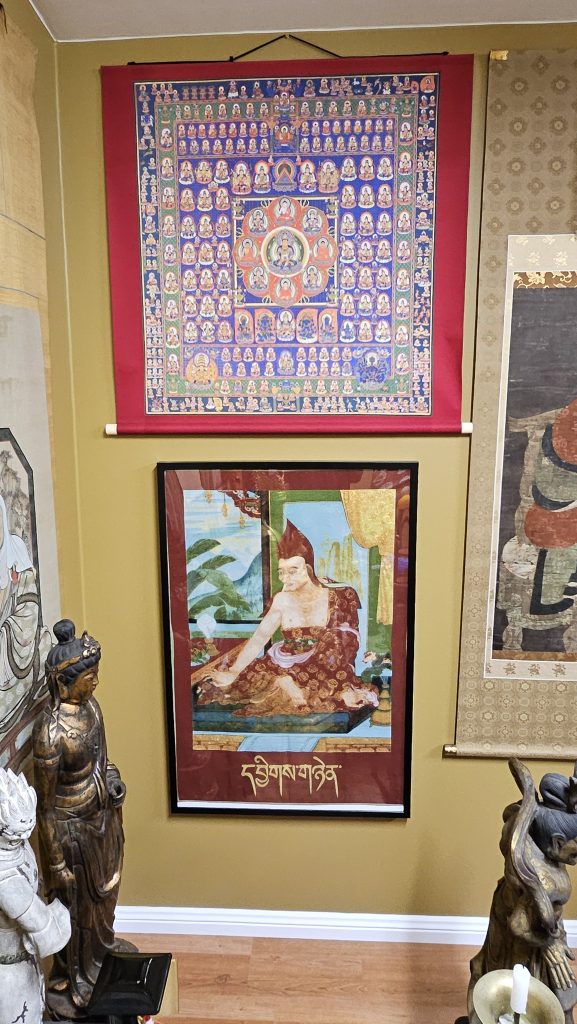
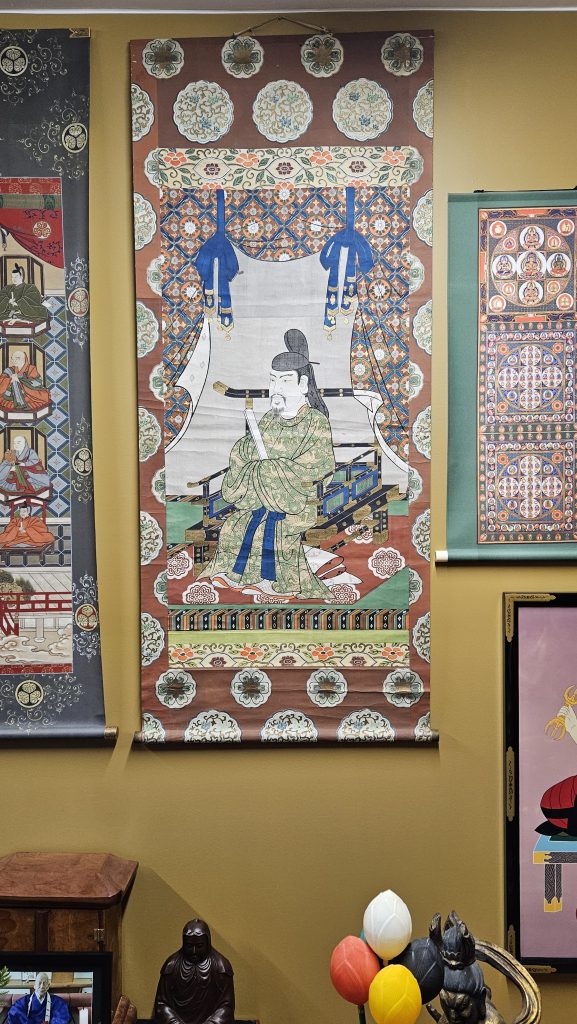
Returning the the left-wall, we have a scroll of Emperor Kammu 桓武天皇 who was our Japanese Founder’s imperial patron. Emperor Kammu lived from 738-806 A.D. and was a staunch supporter and devotee of Tendai Buddhism. Without him we would not have the Tendai school, and from that day to this, the Imperial Family of Japan have been Tendai Buddhists. The Chrysanthemum Crest 菊花紋 of the Imperial Household was designed by Saichō, and the Emperor granted the Tendai School permission to use a modified version as their crest.
Also on the left-wall is a copy of the Sannō Mandala 山王曼荼羅 which depicts the Shinto Deities 神 of Mount Hiei 比叡山, where our Head Temple 総本山 is located. The Mandala is made up of an inner and outer court. The seven figures from the top of the Mandala down to the end of the tiled area, represent the Seven Deities of Mount Hiei 山王七社, while the monkey dressed in clothing, and the man who sits opposite him are the this worldly messengers of the Mountain. These deities are those who answered the prayers of Saichō’s father for a child, and also gave their permission for the founding of the Tendai school on its peaks. Anyone who ordains in the Tendai school and trains on Mount Hiei, offers prayers to the deities of the mountain to bless their training, and we offer prayers to the mountain in gratitude regularly. Perhaps one day, Indigenous Australian Spirits will give their blessing for our own endeavours…


Returning to the right-wall once more, we have a copy of an original image of Jikaku Daishi Ennin 慈覺大師 圓仁 (794-864 A.D.). Ennin became a disciple of Saichō at 15 years of age, and was perhaps more responsible than anyone else for the growth of the Tendai school. He returned to China in order to complete the Esoteric Transmissions of Tendai 台密, and witnessed the Huichang Persecution of Buddhism 會昌廢佛. At least 4,600 temples were destroyed and 260,000 monastics defrocked. Chinese Buddhism would never again rise to the heights it enjoyed before these events, and Ennin managed to ensure that many treasures did not disappear forever.
Further along the right-wall is this old scroll of Ganzan Daishi Ryōgen 元三大師 良源 (912-985 A.D.). Ryōgen was perhaps one of Japanese history’s greatest debaters, and is to be credited with bringing the Tendai school to the height of its influence. Such was the influence achieved by the Tendai school during Ryōgen‘s life, that all of the Kamakura Reformers a few centuries later who went on to found their own schools, emerged from the womb of the Tendai school. His debate record is also thought to have all but guaranteed the end of Hossō schoolʼs 法相宗 influence on Japanese Buddhism.


Next to Ryōgen is this image of Jigen Daishi Tenkai 慈眼大師 天海 (1536-1643). Tenkai was instrumental in acquiring permission to rebuild our Head Temple of Enryakuji 延暦寺 after its destruction by Oda Nobunaga 織田信長. Without his efforts, the Tendai school may never have recovered. Very little is known of his early life, and one popular folk tale is that he was in fact the samurai Akechi Mitsuhide 明智光秀, responsible for assassinating Oda Nobunaga for his destruction of Mount Hiei. Those enjoying the recent miniseries Shōgun 2024, will know of Akechi Mitsuhide’s story, via the novel’s mirror-character, Akechi Jinsai. We will never know for sure if these folk tales have any truth in them. Nevertheless, he worked tirelessly to rebuild the Tendai establishment.
Finally, we have a very old scroll which Jikai had repaired, depicting Chishō Daishi Enchin 智證大師 圓珍 (814-891 A.D.). Enchin became a disciple of Gishin 義真 at 14 years old. His teacher Gishin travelled to China with Saichō as the Chinese translator. Like Ennin, Enchin travelled to China where he spent five years. During this time he even trained at the Qinglongsi 青龍寺 Temple, where Kukai 空海 had trained. Enchin’s disciples would come to be associated with the Onjōji 園城寺 Temple at the foot of Mount Hiei. In time, his lineage-descendants would come to be known as the Jimon Sub-lineage 寺門派 of Tendai.


At the back of the temple we have a small altar centred around a statue of Batō Kannon 馬頭観音. This is a manifestation of the Bodhisattva Avalokitesvara, and is specifically tasked with the protection of animals 畜生道.
On the wall to the left of Batō Kannon is an image of the Chinese Tiantai Monk, Yixing 一行禪師 (683–727 A.D.). Not only was Yixing a Tiantai Master, but he also assisted with the translation of Esoteric texts under the supervision of Śubhakarasiṃha 善無畏. He subsequently wrote a commentary on the Mahāvairocana Sūtra 大日經疏/ 大日經義釋. For these reasons he came to symbolise the ideal Tendai practitioner who successfully melded the Lotus Sūtra Tiantai Teachings with the Esoteric Teachings.
On the right is a charcoal rubbing depicting the Chinese Tiantai and Vinaya Master, Kakai Daishi Ganjin/Jianzhen 過海大師 鑒真. Jianzhen was a Tiantai lineage-holder whose teacher had studied under Zhiyi’s own disciple Guanding 灌頂. Though Master Jianzhen is not officially part of the Japanese Tendai lineage per se, his role in the bringing of Tiantai texts to Japan which Saichō subsequently read, cannot be overstated and must be considered the work of the Buddhas.
Another charcoal-rubbing of the Great Tripitakacarya Xuanzang 玄奘三藏 is also displayed at Enmitsuji. Although strictly speaking, Xuanzang is a monk of the Yogācāra school 瑜伽行派/ 法相宗, and not of our lineage, he dedicated his life to the translation of Buddhist texts. His output has never been matched, and without him much of Indian Buddhism would have disappeared when the Lamp of the Buddhas-Dharma was snuffed out there. Most Westerners will be familiar with Xuanzang via the novelisation of his life, made famous in the t.v. series “Monkey Magic“. As one our temple’s goals is to function as a “Translation Temple“, we pay our respects to those who have come before us.

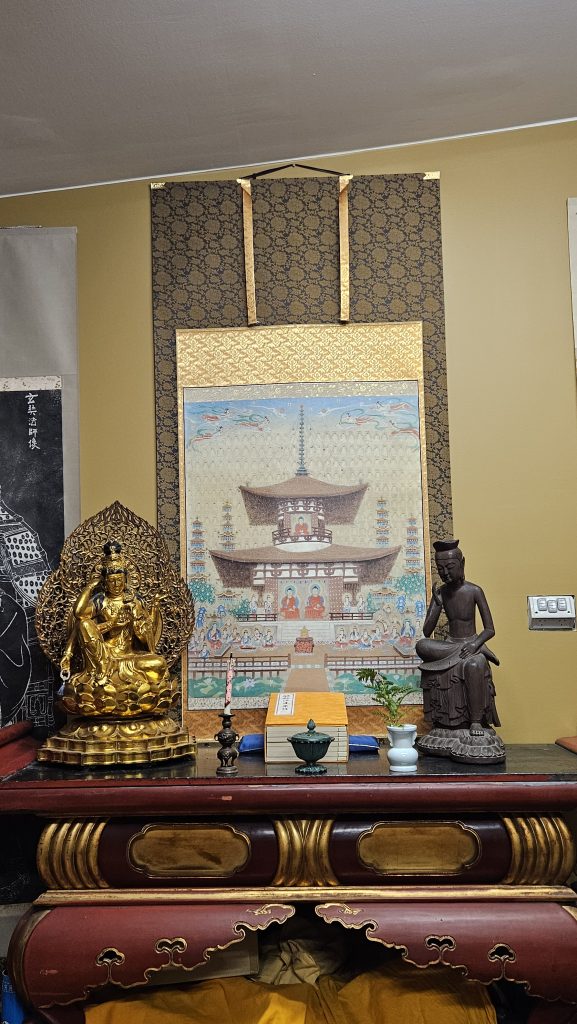
The back wall of the temple has an altar dedicated to the Lotus Sūtra. The scroll in the centre depicts the Assembly on Vulture Peak, with the Two Buddhas Sharing a Seat 二佛並坐 within the Stupa. The statue on the left is of Nyoirin Kannon 如意輪観音 or Cakravarticintāmaṇi Avalokiteśvara. Each of her six arms helps beings in each of the Six Realms. The statue on the right is of the Bodhisattva Maitreya or Miroku Bosatsu 彌勒菩薩. He is the next Buddha, and presently resides in the Tuṣita Heaven 兜率天 for the time to re-introduce the Dharma to the world.
In front of the scroll depicting the Assembly on Vulture Peak, is a copy of the Lotus Sūtra from the Guoqingsi Temple 國清寺 on Mount Tiantai 天台山. It is formally enshrined at the temple, and prayers are offered daily.
Lastly, a scroll showing Prince Shōtoku 聖徳太子 as a bodhisattva. Prince Shōtoku was an early supporter of Buddhism in Japan, and has often been identified in the Tendai tradition as the later-manifestation of Zhiyi’s Master Huisi 慧思, who vowed to be reborn in an Eastern Land to spread the Dharma.
To his right is calligraphy in the Sanskrit Siddham script 悉曇, of the mantra of Benzaiten 辨財天 or the Hindu deity Sarasvatī.
Above this calligraphy is a small statue of an apsara or Heavenly Musicians who adorn the Pure Lands.
And this completes our “temple-tour”. We hope these icons inspire your practise in myriad ways.
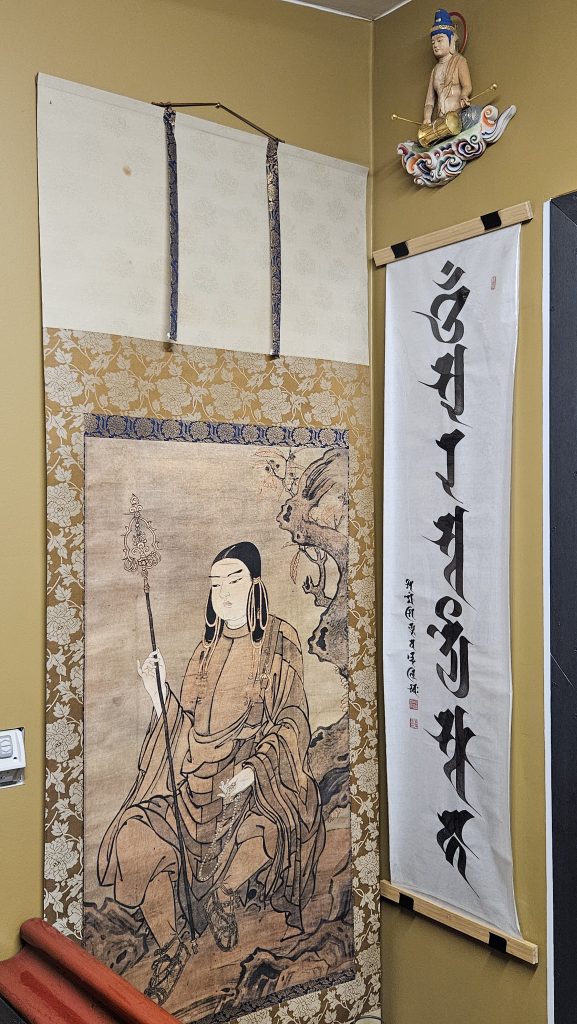

All of the statues and images at Enmitsuji Temple were painstakingly acquired over Reverend Jikai’s five years in Japan. The temple furniture and these icons were then shipped at great expense back to Sydney, Australia. Reverend Jikai was aware that his small temple, would constitute the only contact with the Tendai school that most Australians might encounter. And he therefore wished to make available as many of the great riches this wonderful tradition possesses, as he could. The statues and images housed here represent our hopes for a vibrant and robust transmission of the Tendai School to the West. May the Tiantai/Tendai School be Transmitted Far and Wide!
天台宗永永流轉!
信は荘厳より生ず。。。
